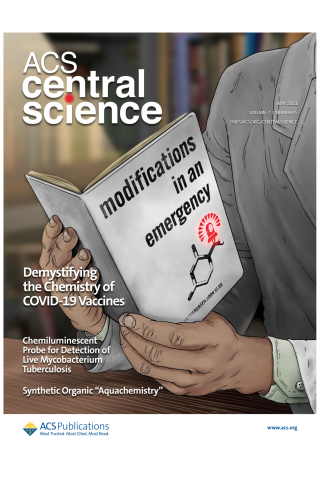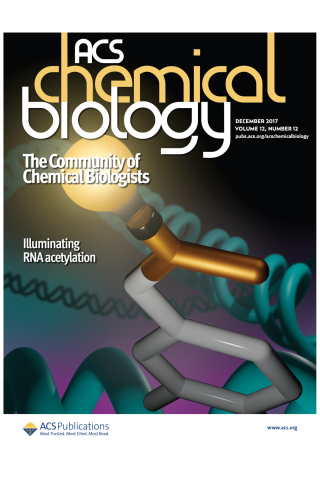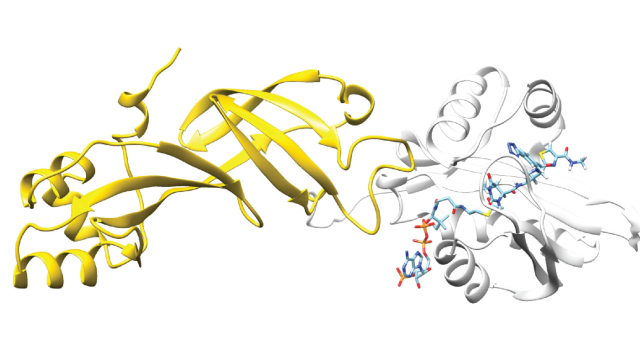
Jordan L. Meier, Ph.D.
- Center for Cancer Research
- National Cancer Institute
- Building 538, Room 245
- Frederick, MD 21702-1201
- 301-228-4889
- jordan.meier@nih.gov
RESEARCH SUMMARY
Epigenetic mechanisms—factors other than an individual’s DNA sequence—play a critical role in the regulation of gene expression and undergo routine disruption in cancer. Dr. Meier’s work focuses on the development of chemical approaches to study epigenetic signaling and its relationship to cellular metabolism. The goal of these studies is to better elucidate the underlying logic linking gene expression and metabolism, and apply this knowledge towards new approaches to cancer therapy, diagnosis, and chemoprevention.
Areas of Expertise

Jordan L. Meier, Ph.D.
Research
Metabolic Regulation of Epigenetic Signaling
Recent studies have shown that many enzymes active in epigenetic mechanisms of genomic regulation are sensitive to the metabolic state of the cell. A major aim of the lab is to understand the mechanisms by which metabolic perturbations influence genomic signaling mediated by chromatin modifying enzymes. Long term goals of this work include: 1) the discovery of biological mechanisms underlying oncometabolite-driven cancers, 2) the development of new diagnostics for cancers driven by metabolic mutations, and 3) the identification of small molecules which inhibit epigenetic modifications through metabolic disruption.
New Acetylation-Based Signaling Mechanisms
Acetyl-CoA links metabolism and signaling by mediating protein and nucleic acid modifications known as acetylations, whose modulation is an emerging paradigm in cancer treatment. A major focus of the laboratory is applying chemical approaches to discover and characterize new enzymatic and non-enzymatic acetylation mechanisms involved in fundamental biology and disease. By expanding the pharmacological map of acetylation-based signaling mechanisms in cancer, these studies aim to uncover new avenues for therapeutic development.
Fumarate Chemoproteomic Reactivity Database
To enable community efforts we have developed a web searchable database of FH-regulated cysteines identified by Kulkarni et al. (“A chemoproteomic portrait of the oncometabolite fumarate,” Nat. Chem Biol., 2019). It can be accessed at: https://ccr2.cancer.gov/resources/Cbl/Proteomics/Fumarate/
Publications
- Bibliography Link
- View Dr. Meier's Complete Bibliography at NCBI.
A Systems Chemoproteomic Analysis of Acyl-CoA/Protein Interaction Networks
Epigenetic regulation by endogenous metabolite pharmacology
A chemoproteomic portrait of the oncometabolite fumarate
Bioorthogonal pro-metabolites for profiling short chain fatty acylation
Discovering Targets of Non-enzymatic Acylation by Thioester Reactivity Profiling
Biography

Jordan L. Meier, Ph.D.
Dr. Meier received his undergraduate degree in chemistry from Creighton University in 2004, getting introduced to research as an National Science Foundation REU student. Following graduation he moved to the University of California-San Diego, performing graduate research in natural products biochemistry and proteomics under the mentorship of Professor Michael D. Burkart. After receiving his Ph.D. in chemistry in 2009, he moved to the California Institute of Technology. His research as an American Cancer Society postdoctoral fellow in the laboratory of Professor Peter B. Dervan focused on the development of high-throughput sequencing methods to analyze small molecule-DNA interactions. In 2013, Dr. Meier joined the NCI, where his research focuses on the development of synthetic probes to investigate metabolic and epigenetic signaling pathways in cancer.
Job Vacancies
We have no open positions in our group at this time, please check back later.
To see all available positions at CCR, take a look at our Careers page. You can also subscribe to receive CCR's latest job and training opportunities in your inbox.
Team
News
Covers

Modifications in an Emergency: The Role of N1- Methylpseudouridine in COVID-19 Vaccines
The novel coronavirus SARS-CoV-2, the cause of the COVID-19 pandemic, has inspired one of the most efficient vaccine development campaigns in human history. A key aspect of COVID-19 mRNA vaccines is the use of the modified nucleobase N1-methylpseudouridine (m1Ψ) to increase their effectiveness. In this Outlook, we summarize the development and function of m1Ψ in synthetic mRNAs. By demystifying how a novel element within these medicines works, we aim to foster understanding and highlight future opportunities for chemical innovation.
Kellie D. Nance and Jordan L. Meier
ACS Central Science 2021 7 (5), 748-756

Harnessing Ionic Selectivity in Acetyltransferase Chemoproteomic Probes
Chemical proteomics provides a powerful strategy for the high-throughput assignment of enzyme function or inhibitor selectivity. However, identifying optimized probes for an enzyme family member of interest and differentiating signal from the background remain persistent challenges in the field. To address this obstacle, here we report a physiochemical discernment strategy for optimizing chemical proteomics based on the coenzyme A (CoA) cofactor. First, we synthesize a pair of CoA-based sepharose pulldown resins differentiated by a single negatively charged residue and find this change alters their capture properties in gel-based profiling experiments. Next, we integrate these probes with quantitative proteomics and benchmark analysis of “probe selectivity” versus traditional “competitive chemical proteomics.” This reveals that the former is well-suited for the identification of optimized pulldown probes for specific enzyme family members, while the latter may have advantages in discovery applications. Finally, we apply our anionic CoA pulldown probe to evaluate the selectivity of a recently reported small molecule N-terminal acetyltransferase inhibitor. These studies further validate the use of physical discriminant strategies in chemoproteomic hit identification and demonstrate how CoA-based chemoproteomic probes can be used to evaluate the selectivity of small molecule protein acetyltransferase inhibitors, an emerging class of preclinical therapeutic agents.
Yihang Jing, Jose L. Montano, Michaella Levy, Jeffrey E. Lopez, Pei-Pei Kung, Paul Richardson, Krzysztof Krajewski, Laurence Florens, Michael P. Washburn, and Jordan L. Meier
ACS Chemical Biology 2021 16 (1), 27-34

A Chemoproteomic Portrait of the Oncometabolite Fumarate
Hereditary cancer disorders often provide an important window into novel mechanisms supporting tumor growth. Understanding these mechanisms thus represents a vital goal. Toward this goal, here we report a chemoproteomic map of fumarate, a covalent oncometabolite whose accumulation marks the genetic cancer syndrome hereditary leiomyomatosis and renal cell carcinoma (HLRCC). We applied a fumarate-competitive chemoproteomic probe in concert with LC–MS/MS to discover new cysteines sensitive to fumarate hydratase (FH) mutation in HLRCC cell models. Analysis of this dataset revealed an unexpected influence of local environment and pH on fumarate reactivity, and enabled the characterization of a novel FH-regulated cysteine residue that lies at a key protein–protein interface in the SWI-SNF tumor-suppressor complex. Our studies provide a powerful resource for understanding the covalent imprint of fumarate on the proteome and lay the foundation for future efforts to exploit this distinct aspect of oncometabolism for cancer diagnosis and therapy.
Rhushikesh A. Kulkarni, Daniel W. Bak, Darmood Wei, Sarah E. Bergholtz, Chloe A. Briney, Jonathan H. Shrimp, Aktan Alpsoy, Abigail L. Thorpe, Arissa E. Bavari, Daniel R. Crooks, Michaella Levy, Laurence Florens, Michael P. Washburn, Norma Frizzell, Emily C. Dykhuizen, Eranthie Weerapana, W. Marston Linehan and Jordan L. Meier
Nature Chemical Biology, 2019, 15 (4), 391.

Photoinducible Oncometabolite Detection
Dysregulated metabolism can fuel cancer by altering the production of bioenergetic building blocks and directly stimulating oncogenic gene-expression programs. However, relatively few optical methods for the direct study of metabolites in cells exist. To address this need and facilitate new approaches to cancer treatment and diagnosis, herein we report an optimized chemical approach to detect the oncometabolite fumarate. Our strategy employs diaryl tetrazoles as cell-permeable photoinducible precursors to nitrileimines. Uncaging these species in cells and cell extracts enables them to undergo 1,3-dipolar cycloadditions with endogenous dipolarophile metabolites such as fumarate to form pyrazoline cycloadducts that can be readily detected by their intrinsic fluorescence. The ability to photolytically uncage diaryl tetrazoles provides greatly improved sensitivity relative to previous methods, and enables the facile detection of dysregulated fumarate metabolism through biochemical activity assays, intracellular imaging, and flow cytometry. Our studies showcase an intersection of bioorthogonal chemistry and metabolite reactivity that can be applied for biological profiling, imaging, and diagnostics.
Rhushikesh A. Kulkarni Chloe A. Briney, Daniel R. Crooks, Sarah E. Bergholtz, Chandrasekhar Mushti, Stephen J. Lockett, Andrew N. Lane, Teresa W.‐M. Fan, Rolf E. Swenson, W. Marston Linehan and Jordan L. Meier
ChemBioChem, 2019, 20 (3), 360.

Pharmacology by Chemical Biology
The real voyage of discovery consists not in seeking new landscapes, but in having new eyes.
~ Marcel Proust
Pharmacology is a science deeply rooted not only in manipulating physiology but also in defining the mechanism of therapeutic compounds so that they may be more precisely deployed. For example, studies by Sydney Farber revealed the potential of antifolates as drugs for the treatment of childhood leukemia, which led to mechanistic efforts that defined dihydrofolate reductase as a drug target. This discovery in turn enabled the development of novel anticancer and antibacterial agents, as well as new methods for probing biology using inducible dimerization. In this special issue of Molecular Pharmaceutics, “Pharmacology by Chemical Biology”, we highlight a diverse collection of chemical advances which may be used to treat disease or study drug action, and thus impact our understanding of pharmacology.
Jordan L. Meier and Martin J. Schnermann
Molecular Pharmaceutics, 2018, 15 (3), 703-704.

Profiling Cytidine Acetylation with Specific Affinity and Reactivity
The human acetyltransferase NAT10 has recently been shown to catalyze formation of N4-acetylcytidine (ac4C), a minor nucleobase known to alter RNA structure and function. In order to better understand the role of RNA acetyltransferases in biology and disease, here we report the development and application of chemical methods to study ac4C. First, we demonstrate that ac4C can be conjugated to carrier proteins using optimized protocols. Next, we describe methods to access ac4C-containing RNAs, enabling the screening of anti-ac4C antibodies. Finally, we validate the specificity of an optimized ac4C affinity reagent in the context of cellular RNA by demonstrating its ability to accurately report on chemical deacetylation of ac4C. Overall, these studies provide a powerful new tool for studying ac4C in biological contexts, as well as new insights into the stability and half-life of this highly conserved RNA modification. More broadly, they demonstrate how chemical reactivity may be exploited to aid the development and validation of nucleobase-targeting affinity reagents designed to target the emerging epitranscriptome.
See: Profiling Cytidine Acetylation with Specific Affinity and Reactivity by Wilson R. Sinclair, Daniel Arango, Jonathan H. Shrimp, Thomas T. Zengeya, Justin M. Thomas, David C. Montgomery, Stephen D. Fox, Thorkell Andresson, Shalini Oberdoerffer, and Jordan L. Meier in ACS Chemical Biology, 2017, 12 (12), 2922-2926.

Discovering Targets of Non-enzymatic Acylation by Thioester Reactivity Profiling
The cover image illuminates the non-enzymatic “ghost writers” of lysine acylation. Meier et al. detail the development of a chemoproteomic strategy that harnesses thioester reactivity to discover candidate cellular targets of non-enzymatic acylation. Application of this approach reveals that glycolytic enzymes can be strongly inhibited by reactive thioesters, including the fatty acid precursor malonyl-CoA. This study provides new insights into the metabolic regulation of lysine acetylation, and highlights the utility of reactivity-based methods to define and manipulate non-enzymatic protein modifications in complex biological settings.
Cover art by Scientific Publications, Graphics & Media, Frederick National Laboratory for Cancer Research.
Rhushikesh A. Kulkarni, Andrew J. Worth, Thomas T. Zengeya, Jonathan H. Shrimp, Julie M. Garlick, Allison M. Roberts, David C. Montgomery, Carole Sourbier, Benjamin K. Gibbs, Clementina Mesaros, Yien Che Tsai, Sudipto Das, King C. Chan, Ming Zhou, Thorkell Andresson, Allan M. Weissman, W. Marston Linehan, Ian A. Blair, Nathaniel W. Snyder, Jordan L. Meier
Cell Chemical Biology, 2017, 24 (2), 231-242.

Metabolic regulation of histone acetyltransferases by endogenous Acyl-CoA cofactors
Unraveling the metabolic regulation of lysine acetyltransferases (KATs). Montgomery et al. detail the application of a competitive chemoproteomic strategy to quantitatively characterize the interactions of acyl-CoA metabolites with cellular KAT enzymes. These studies reveal KATs are strongly inhibited by lipid-derived CoA analogs, an interaction that may have implications for the metabolic regulation of epigenetic signaling, and highlight the power of chemoproteomics to rapidly characterize metabolic-epigenetic interactions in complex biological contexts.
Cover design by Scientific Publications, Graphics & Media, Frederick National Laboratory for Cancer Research.
David C. Montgomery#, Alexander W. Sorum#, Laura Guasch, Marc C. Nicklaus and Jordan L. Meier
Chemistry & Biology, 2015, 22, 1030-1039.
#Co-first author
Lab Life
Alumni
| David Montgomery 2013-2017 Postdoctoral Fellow |
Allison Roberts 2014-2015 Postbaccalaureate Fellow |
Thomas Zengeya 2013-2017 Postdoctoral Fellow |
|---|---|---|
| Rhushi Kulkarni 2013-2018 Postdoctoral Fellow |
Jonathan Shrimp 2014-2019 Postdoctoral Fellow |
Jeff Lopez 2017-2019 Postdoctoral Fellow |
| Justin Thomas 2017-2019 Postdoctoral Fellow |
Alexander Sorum 2013-2015 Postbaccalaureate Fellow |
Wilson Sinclair 2015-2017 Postbaccalaureate Fellow |
| Julie Garlick 2015-2016 Postbaccalaureate Fellow |
Abbey Thorpe 2017-2018 Postbaccalaureate Fellow |
Sarah Bergholtz 2017-2019 Postbaccalaureate Fellow |
| Chloe Briney 2017-2019 Postbaccalaureate Fellow |
||















